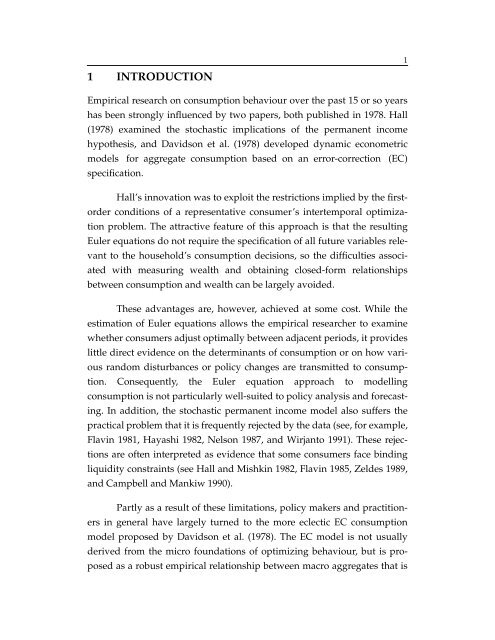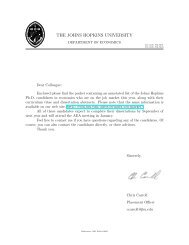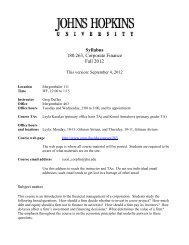WEALTH, DISPOSABLE INCOME AND CONSUMPTION - Economics
WEALTH, DISPOSABLE INCOME AND CONSUMPTION - Economics
WEALTH, DISPOSABLE INCOME AND CONSUMPTION - Economics
Create successful ePaper yourself
Turn your PDF publications into a flip-book with our unique Google optimized e-Paper software.
1 INTRODUCTION<br />
Empirical research on consumption behaviour over the past 15 or so years<br />
has been strongly influenced by two papers, both published in 1978. Hall<br />
(1978) examined the stochastic implications of the permanent income<br />
hypothesis, and Davidson et al. (1978) developed dynamic econometric<br />
models for aggregate consumption based on an error-correction (EC)<br />
specification.<br />
Hall’s innovation was to exploit the restrictions implied by the firstorder<br />
conditions of a representative consumer’s intertemporal optimization<br />
problem. The attractive feature of this approach is that the resulting<br />
Euler equations do not require the specification of all future variables relevant<br />
to the household’s consumption decisions, so the difficulties associated<br />
with measuring wealth and obtaining closed-form relationships<br />
between consumption and wealth can be largely avoided.<br />
These advantages are, however, achieved at some cost. While the<br />
estimation of Euler equations allows the empirical researcher to examine<br />
whether consumers adjust optimally between adjacent periods, it provides<br />
little direct evidence on the determinants of consumption or on how various<br />
random disturbances or policy changes are transmitted to consumption.<br />
Consequently, the Euler equation approach to modelling<br />
consumption is not particularly well-suited to policy analysis and forecasting.<br />
In addition, the stochastic permanent income model also suffers the<br />
practical problem that it is frequently rejected by the data (see, for example,<br />
Flavin 1981, Hayashi 1982, Nelson 1987, and Wirjanto 1991). These rejections<br />
are often interpreted as evidence that some consumers face binding<br />
liquidity constraints (see Hall and Mishkin 1982, Flavin 1985, Zeldes 1989,<br />
and Campbell and Mankiw 1990).<br />
Partly as a result of these limitations, policy makers and practitioners<br />
in general have largely turned to the more eclectic EC consumption<br />
model proposed by Davidson et al. (1978). The EC model is not usually<br />
derived from the micro foundations of optimizing behaviour, but is proposed<br />
as a robust empirical relationship between macro aggregates that is<br />
1




